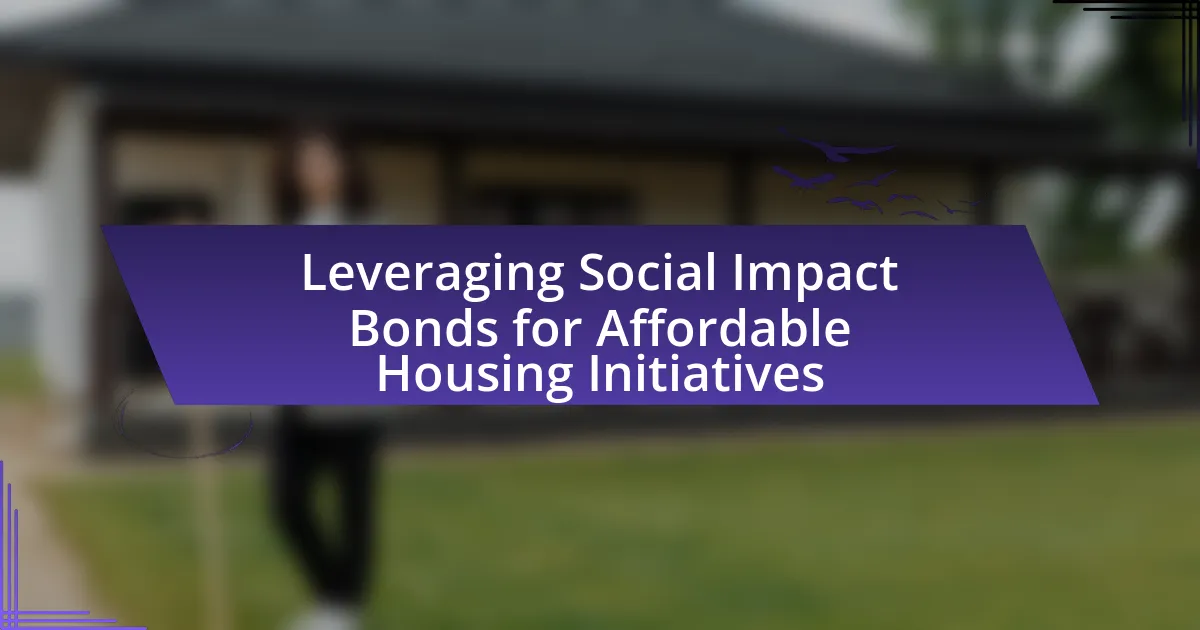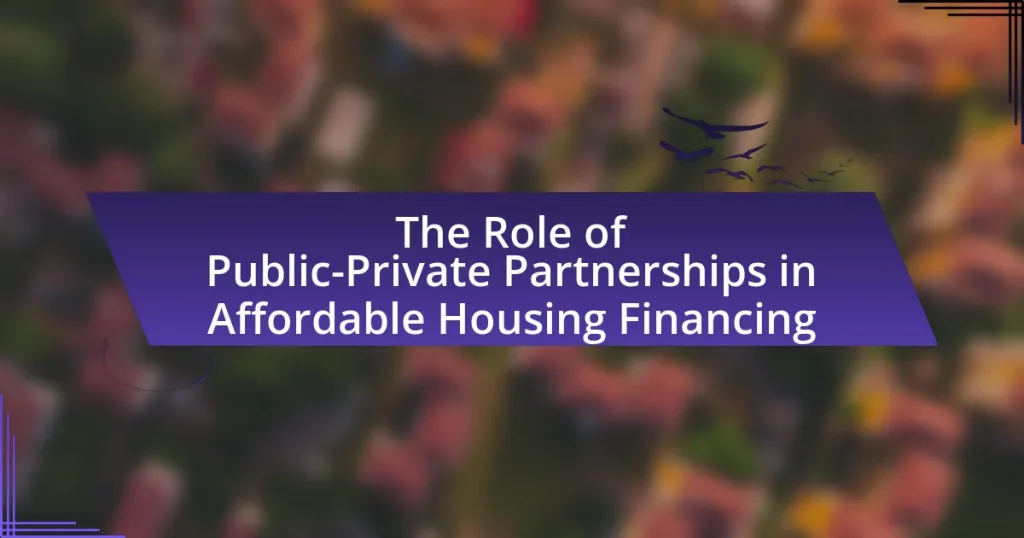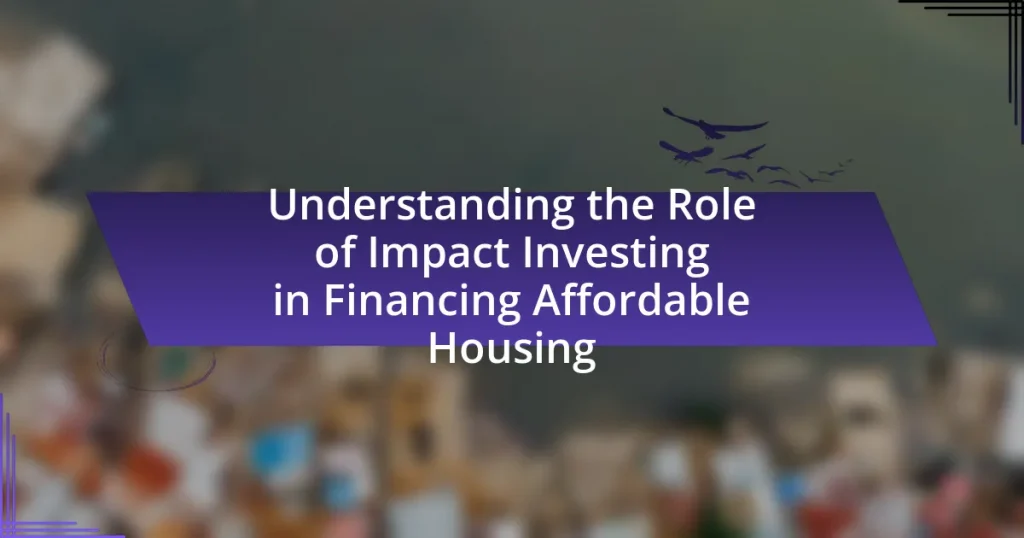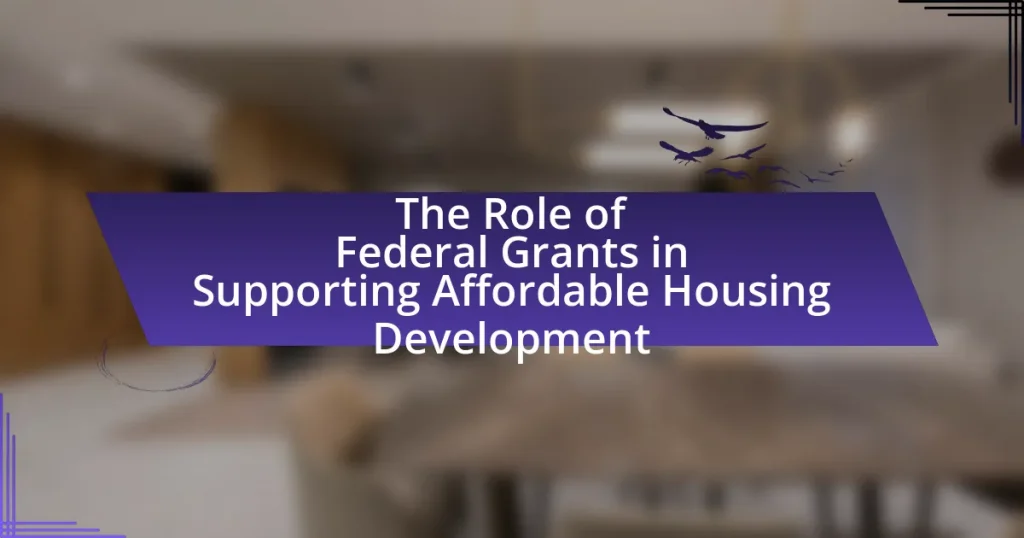Social Impact Bonds (SIBs) are innovative financial instruments designed to attract private investment for social programs, particularly in the realm of affordable housing initiatives. This article explores how SIBs facilitate funding for projects aimed at reducing homelessness and improving housing stability by linking investor returns to specific social outcomes. It examines the roles of various stakeholders involved, the differences between SIBs and traditional funding methods, and the benefits of leveraging SIBs for affordable housing. Additionally, the article addresses the challenges in implementing SIBs, including measurement complexities and stakeholder alignment, while highlighting best practices for successful project execution.
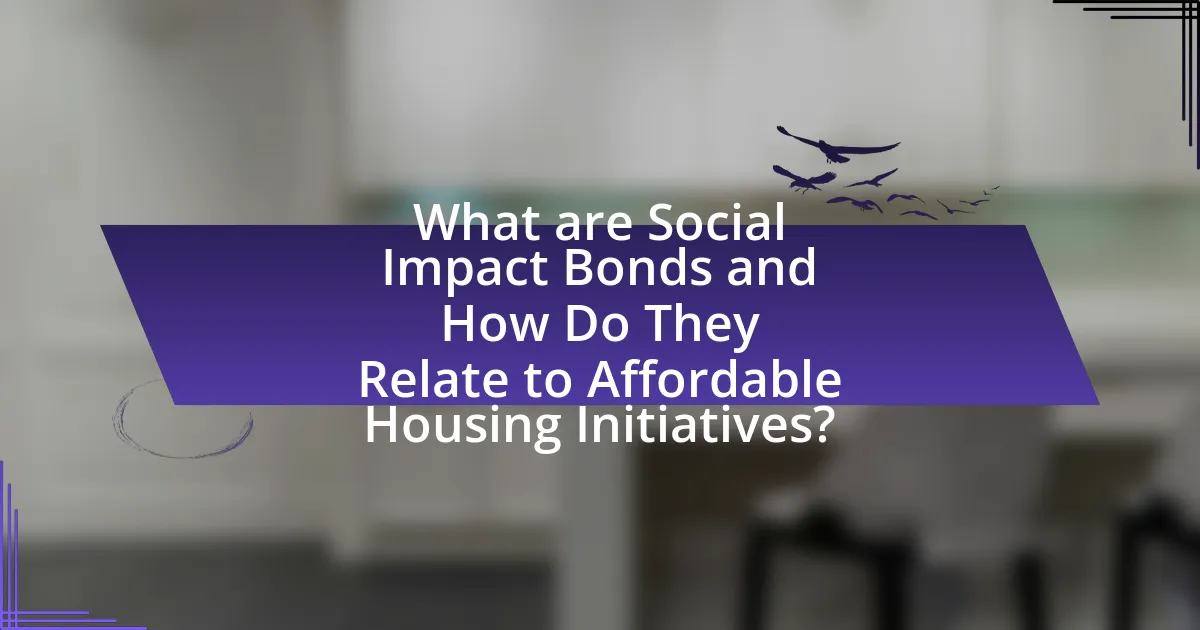
What are Social Impact Bonds and How Do They Relate to Affordable Housing Initiatives?
Social Impact Bonds (SIBs) are financial instruments that facilitate funding for social programs by attracting private investment to address social issues, with returns linked to the achievement of specific outcomes. In the context of affordable housing initiatives, SIBs can be utilized to finance projects aimed at reducing homelessness or increasing access to affordable housing, where investors receive a return on their investment only if the project meets predetermined success metrics, such as reduced emergency service costs or improved housing stability. For example, the Social Impact Bond launched in Utah in 2015 aimed to reduce homelessness among vulnerable populations, demonstrating how SIBs can effectively mobilize resources for affordable housing solutions while ensuring accountability and measurable impact.
What is the purpose of Social Impact Bonds in the context of affordable housing?
The purpose of Social Impact Bonds (SIBs) in the context of affordable housing is to finance initiatives that aim to improve housing stability and reduce homelessness. SIBs attract private investment to fund social programs, with returns linked to the achievement of specific social outcomes, such as increased access to affordable housing. For instance, a study by the Urban Institute highlights that SIBs can mobilize capital for innovative housing solutions, demonstrating their effectiveness in addressing housing challenges by aligning financial incentives with social goals.
How do Social Impact Bonds facilitate funding for affordable housing projects?
Social Impact Bonds (SIBs) facilitate funding for affordable housing projects by enabling private investors to finance these initiatives upfront, with the government repaying them based on the achievement of specific social outcomes. This model reduces the financial risk for public entities while attracting capital from private sources, which can be crucial for addressing the funding gap in affordable housing. For instance, a report by the Urban Institute highlights that SIBs can mobilize significant private investment, as seen in projects like the New York City’s SIB for supportive housing, which aimed to reduce homelessness and has shown promising results in both social impact and cost savings for the city.
What stakeholders are involved in Social Impact Bonds for housing initiatives?
The stakeholders involved in Social Impact Bonds for housing initiatives include government entities, private investors, service providers, and beneficiaries. Government entities, such as local or state authorities, typically initiate the bonds to address housing challenges. Private investors provide the capital needed for the initiatives, expecting returns based on the success of the housing programs. Service providers, which can include non-profit organizations or housing developers, implement the programs aimed at improving housing outcomes. Beneficiaries are the individuals or families who receive housing assistance and support through these initiatives. This multi-stakeholder approach is essential for the effective functioning of Social Impact Bonds in addressing housing issues.
How do Social Impact Bonds differ from traditional funding methods for affordable housing?
Social Impact Bonds (SIBs) differ from traditional funding methods for affordable housing primarily in their structure and payment model. SIBs are performance-based financial instruments where private investors fund social programs and are repaid by the government only if the programs achieve predetermined outcomes, such as reduced homelessness or improved housing stability. In contrast, traditional funding methods typically involve upfront government financing or grants without a direct link to specific performance metrics. This performance-based approach in SIBs incentivizes efficiency and accountability, as seen in programs like the Peterborough Social Impact Bond in the UK, which aimed to reduce reoffending rates and demonstrated measurable success before investor repayment.
What are the key differences between Social Impact Bonds and grants?
Social Impact Bonds (SIBs) and grants differ primarily in their funding structure and accountability mechanisms. SIBs are a form of outcome-based financing where private investors fund social programs and are repaid by the government only if the program meets specific performance targets, thus linking financial returns to social outcomes. In contrast, grants provide upfront funding without a direct link to performance outcomes, meaning that funds are allocated based on proposals rather than measurable results. This distinction highlights that SIBs incentivize efficiency and effectiveness in achieving social goals, while grants focus on supporting initiatives without performance-based repayment.
How do risk-sharing mechanisms work in Social Impact Bonds compared to conventional financing?
Risk-sharing mechanisms in Social Impact Bonds (SIBs) involve collaboration between public, private, and nonprofit sectors to distribute financial risks associated with social outcomes, unlike conventional financing, which typically places the entire risk burden on the borrower. In SIBs, investors provide upfront capital for social programs, and they receive returns only if the programs achieve predetermined outcomes, thus aligning financial incentives with social impact. This model reduces the financial risk for public entities, as they only pay for successful results, while conventional financing often requires fixed repayments regardless of program effectiveness, leading to higher risk for the borrower. For instance, the UK’s Peterborough Prison SIB demonstrated this by linking investor returns to recidivism reduction, showcasing how SIBs can effectively share risk while incentivizing positive social outcomes.
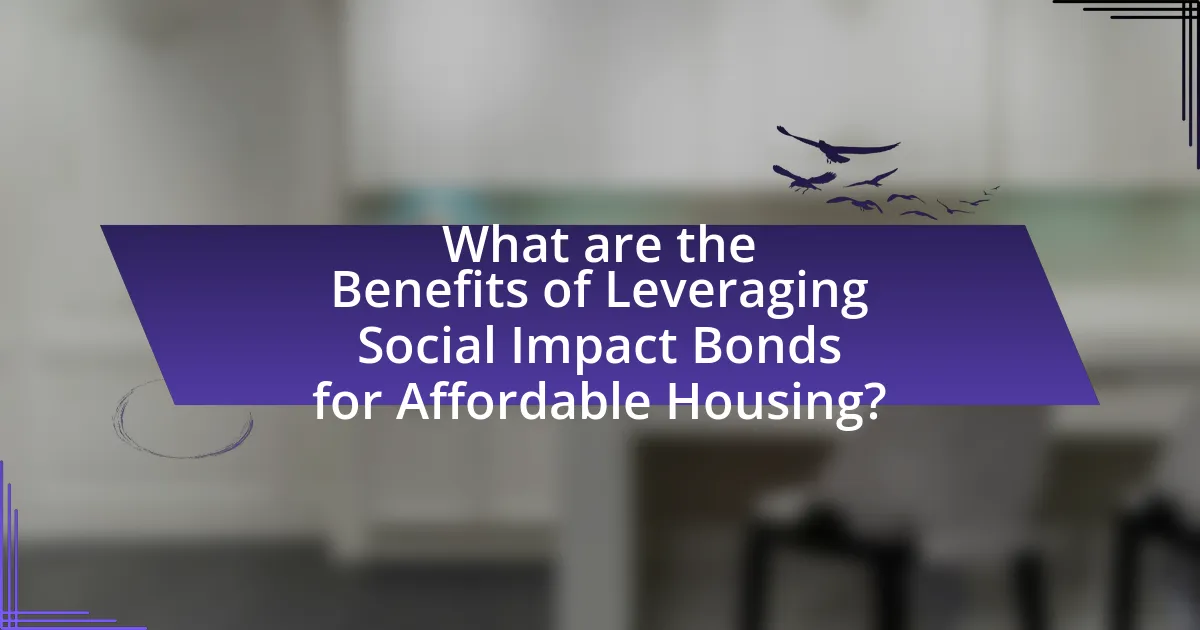
What are the Benefits of Leveraging Social Impact Bonds for Affordable Housing?
Leveraging Social Impact Bonds (SIBs) for affordable housing provides multiple benefits, including increased funding for housing projects, improved accountability, and enhanced collaboration among stakeholders. SIBs attract private investment by offering returns based on the achievement of specific social outcomes, such as reducing homelessness or increasing housing stability. This model incentivizes effective program implementation, as investors only receive returns if measurable results are achieved. For instance, the Social Impact Bond launched in Utah in 2015 aimed to reduce homelessness and successfully housed over 1,000 individuals, demonstrating the potential for SIBs to deliver tangible social benefits while addressing critical housing needs.
How do Social Impact Bonds enhance investment in affordable housing?
Social Impact Bonds (SIBs) enhance investment in affordable housing by providing a financial mechanism that aligns the interests of private investors, government entities, and service providers. SIBs attract private capital to fund housing projects upfront, reducing the financial burden on public budgets. For instance, in the United Kingdom, the Peterborough Social Impact Bond successfully financed programs aimed at reducing recidivism, demonstrating how SIBs can be structured to achieve social outcomes while generating returns for investors. This model incentivizes the development of affordable housing by linking financial returns to measurable social impacts, thus encouraging investment in projects that might otherwise lack funding.
What financial incentives do Social Impact Bonds provide to investors?
Social Impact Bonds (SIBs) provide financial incentives to investors through potential returns linked to the achievement of specific social outcomes. Investors receive payments from the government or other entities if the funded programs meet predetermined performance metrics, such as reduced homelessness or improved housing stability. For example, in the UK, the Peterborough Prison SIB offered investors a return of up to 13% based on recidivism rates, demonstrating how successful outcomes can translate into financial gains. This performance-based model aligns investor interests with social objectives, encouraging funding for initiatives that deliver measurable social benefits.
How do Social Impact Bonds promote accountability and measurable outcomes in housing projects?
Social Impact Bonds (SIBs) promote accountability and measurable outcomes in housing projects by linking funding to specific performance metrics that must be met to secure financial returns. This structure incentivizes service providers to achieve defined social outcomes, such as reducing homelessness or increasing affordable housing availability, as their compensation is contingent upon meeting these targets. For instance, a study by the UK’s Ministry of Housing, Communities and Local Government found that SIBs can lead to improved service delivery and better resource allocation, as stakeholders are held accountable for their performance through transparent reporting and evaluation processes. This accountability ensures that funds are used effectively, ultimately leading to measurable improvements in housing initiatives.
What social outcomes can be achieved through Social Impact Bonds in affordable housing?
Social Impact Bonds (SIBs) in affordable housing can achieve significant social outcomes such as reduced homelessness, improved housing stability, and enhanced community well-being. By financing initiatives that focus on preventive measures and supportive services, SIBs incentivize private investors to fund programs that deliver measurable social benefits. For instance, a study by the Urban Institute found that SIB-funded projects in housing have led to a 20% reduction in homelessness among participants, demonstrating the effectiveness of this financing model in addressing housing insecurity. Additionally, SIBs can facilitate partnerships between government, non-profits, and private sectors, fostering collaborative approaches that enhance resource allocation and service delivery in affordable housing initiatives.
How do Social Impact Bonds contribute to reducing homelessness?
Social Impact Bonds (SIBs) contribute to reducing homelessness by financing preventive and supportive services that help individuals secure stable housing. These financial instruments attract private investment to fund programs aimed at addressing the root causes of homelessness, such as mental health issues, substance abuse, and lack of job training. For instance, a study by the Urban Institute found that SIBs can lead to significant cost savings for governments by reducing the need for emergency services and shelters, as successful interventions lead to long-term housing stability. This model not only incentivizes effective solutions but also holds service providers accountable for achieving measurable outcomes, thereby enhancing the overall efficiency of homelessness reduction efforts.
What role do Social Impact Bonds play in community development and revitalization?
Social Impact Bonds (SIBs) play a crucial role in community development and revitalization by providing a financial mechanism that aligns public and private interests to fund social programs. SIBs enable governments to pay for successful social outcomes, such as reduced homelessness or improved educational attainment, by attracting private investment to fund these initiatives upfront. For instance, the Social Impact Bond launched in Peterborough, England, aimed to reduce recidivism among former prisoners, demonstrating how SIBs can effectively address social issues while revitalizing communities. This model incentivizes investors to support programs that yield measurable social benefits, thereby fostering sustainable community development and revitalization.
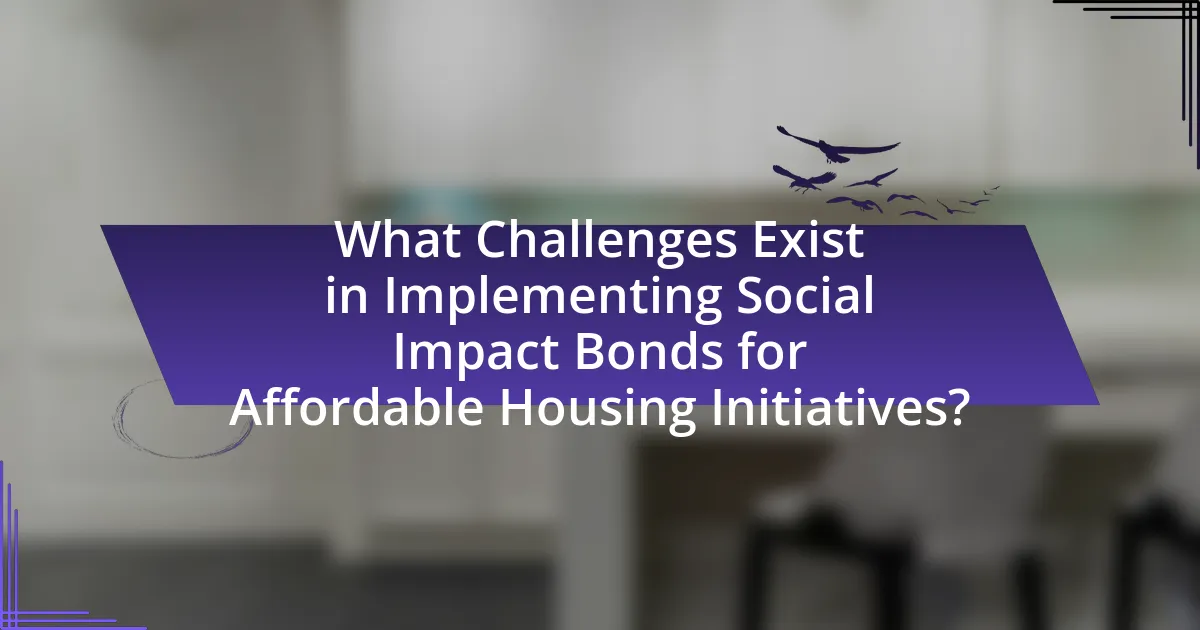
What Challenges Exist in Implementing Social Impact Bonds for Affordable Housing Initiatives?
Implementing Social Impact Bonds (SIBs) for affordable housing initiatives faces several challenges, including complexity in structuring agreements, difficulty in measuring social outcomes, and securing upfront investment. The complexity arises from the need to align interests among various stakeholders, such as government entities, investors, and service providers, which can lead to lengthy negotiations and unclear responsibilities. Measuring social outcomes is challenging due to the need for reliable metrics that accurately reflect the impact of housing initiatives, making it difficult to assess success and secure funding based on results. Additionally, attracting upfront investment can be problematic, as investors may be hesitant to commit capital without guaranteed returns, particularly in a sector with uncertain outcomes like affordable housing. These challenges have been documented in various studies, including the report by the Brookings Institution, which highlights the difficulties in aligning incentives and measuring success in SIB projects.
What are the common barriers to the successful implementation of Social Impact Bonds?
Common barriers to the successful implementation of Social Impact Bonds (SIBs) include insufficient stakeholder engagement, unclear metrics for success, and challenges in financing. Insufficient stakeholder engagement often leads to a lack of collaboration among government entities, service providers, and investors, which is crucial for aligning interests and resources. Unclear metrics for success can hinder the ability to measure outcomes effectively, making it difficult to assess the impact of the SIB. Additionally, challenges in financing arise from the complexity of structuring deals and the perceived risks associated with investing in social outcomes, which can deter potential investors. These barriers have been documented in various studies, including the report by the Harvard Kennedy School, which highlights the importance of clear communication and defined success metrics in overcoming implementation challenges.
How can complexity in measurement and evaluation hinder Social Impact Bonds?
Complexity in measurement and evaluation can significantly hinder Social Impact Bonds (SIBs) by creating challenges in assessing outcomes and determining success. When the metrics for evaluating social outcomes are overly complicated, it becomes difficult for stakeholders to agree on what constitutes success, leading to misalignment between investors, service providers, and government entities. For instance, if a SIB aimed at affordable housing lacks clear, standardized metrics for measuring housing stability or quality of life improvements, it can result in disputes over performance outcomes, ultimately affecting funding and support. Furthermore, complex evaluation processes can increase administrative costs and time delays, reducing the overall effectiveness and attractiveness of SIBs as a financing mechanism for social initiatives.
What challenges do stakeholders face in aligning interests and objectives?
Stakeholders face significant challenges in aligning interests and objectives due to differing priorities and incentives. For instance, government entities may prioritize cost-effectiveness and public accountability, while private investors often focus on financial returns. This divergence can lead to conflicts in decision-making processes, as seen in various affordable housing initiatives where public and private sector goals do not align. Additionally, stakeholders may encounter difficulties in communication and trust-building, which are essential for collaboration. Research indicates that successful partnerships in social impact bonds require clear frameworks and shared metrics to measure success, yet these are often lacking, complicating alignment efforts.
How can these challenges be addressed to improve the effectiveness of Social Impact Bonds?
To improve the effectiveness of Social Impact Bonds (SIBs), stakeholders can enhance collaboration among public, private, and nonprofit sectors. This collaboration can lead to better alignment of goals, resources, and expertise, which is crucial for addressing the complexities of affordable housing initiatives. For instance, successful SIBs often involve clear performance metrics and shared accountability, ensuring that all parties are invested in achieving measurable outcomes. Research indicates that SIBs with well-defined metrics and strong partnerships have higher success rates, as seen in the UK’s Peterborough Prison project, which demonstrated reduced recidivism through coordinated efforts. By fostering these collaborative environments and focusing on measurable results, the challenges faced by SIBs can be effectively mitigated, leading to improved outcomes in affordable housing initiatives.
What best practices can be adopted for successful Social Impact Bond projects?
Successful Social Impact Bond projects can be achieved by establishing clear objectives, engaging stakeholders, and ensuring robust evaluation mechanisms. Clear objectives provide a focused framework for measuring success, while stakeholder engagement fosters collaboration and alignment of interests among investors, service providers, and government entities. Robust evaluation mechanisms, including predefined metrics and regular assessments, ensure accountability and facilitate data-driven decision-making. Research indicates that projects with these best practices tend to achieve better outcomes, as evidenced by the success of the Peterborough Social Impact Bond in the UK, which demonstrated significant reductions in reoffending rates through structured evaluation and stakeholder collaboration.
How can collaboration among stakeholders enhance the success of Social Impact Bonds?
Collaboration among stakeholders enhances the success of Social Impact Bonds (SIBs) by fostering shared goals, pooling resources, and leveraging diverse expertise. When stakeholders such as government agencies, non-profits, and private investors work together, they can align their objectives to address specific social issues effectively, such as affordable housing. This alignment increases the likelihood of achieving measurable outcomes, which are essential for the financial viability of SIBs. For instance, a study by the Harvard Kennedy School found that collaborative approaches in SIB projects led to improved service delivery and better resource allocation, ultimately resulting in higher success rates. By combining their strengths, stakeholders can create innovative solutions that address complex social challenges, thereby enhancing the overall impact and sustainability of Social Impact Bonds.
What are the key considerations for stakeholders looking to engage with Social Impact Bonds for affordable housing?
Key considerations for stakeholders engaging with Social Impact Bonds (SIBs) for affordable housing include understanding the financial structure, measuring social outcomes, and ensuring stakeholder alignment. Stakeholders must grasp how SIBs function, where private investors fund social programs and are repaid by the government based on achieved outcomes. Accurate measurement of social impact is critical, as it determines the success of the investment and repayment terms; for instance, the UK’s Peterborough Prison SIB demonstrated the importance of clear metrics for success. Additionally, alignment among stakeholders—such as government entities, investors, and service providers—is essential to ensure that all parties share common goals and expectations, which enhances the likelihood of achieving desired housing outcomes.
What steps should investors take to evaluate potential Social Impact Bond projects?
Investors should take the following steps to evaluate potential Social Impact Bond (SIB) projects: first, assess the social issue being addressed by the project, ensuring it aligns with measurable outcomes and community needs. Next, analyze the project’s financial structure, including the return on investment and risk factors associated with the bond. Additionally, review the track record of the service providers involved, focusing on their experience and success in delivering similar outcomes. Finally, evaluate the metrics and evaluation framework that will be used to measure success, ensuring they are robust and transparent. These steps are critical as they help investors make informed decisions based on evidence and the potential for social impact.
How can housing organizations effectively communicate their needs to potential investors?
Housing organizations can effectively communicate their needs to potential investors by clearly articulating their objectives, demonstrating the social impact of their initiatives, and providing data-driven evidence of past successes. For instance, presenting specific metrics such as the number of affordable housing units created or the percentage reduction in homelessness can illustrate the effectiveness of their programs. Additionally, utilizing case studies that highlight successful partnerships and outcomes can build credibility and trust with investors. Research indicates that organizations that employ transparent communication strategies and align their goals with the values of investors are more likely to secure funding, as seen in the success of various Social Impact Bond projects that have attracted significant investment by showcasing measurable social returns.
